Welcome to the world of Mid-Century Modern design, where timeless elegance meets functional simplicity! Whether you’re a beginner dipping your toes into the exciting realm of interior design or a seasoned decorator seeking fresh inspiration, this guide promises to be a treasure trove of transformative ideas. Here, you’ll find twelve carefully curated tips that celebrate the unique charm of Mid-Century Modern style, offering both aesthetic inspiration and practical know-how.
Incorporating Mid-Century Modern elements into your home is more than just embracing a design trend—it’s about creating spaces that resonate with warmth, creativity, and personal expression. This guide will equip you with the confidence to experiment with iconic designs and modern twists, empowering you to turn your living spaces into stylish sanctuaries. With these tips, you’ll not only enhance the visual appeal of your home but also enjoy the satisfaction that comes from a successful design journey.
Incorporate Iconic Furniture Pieces
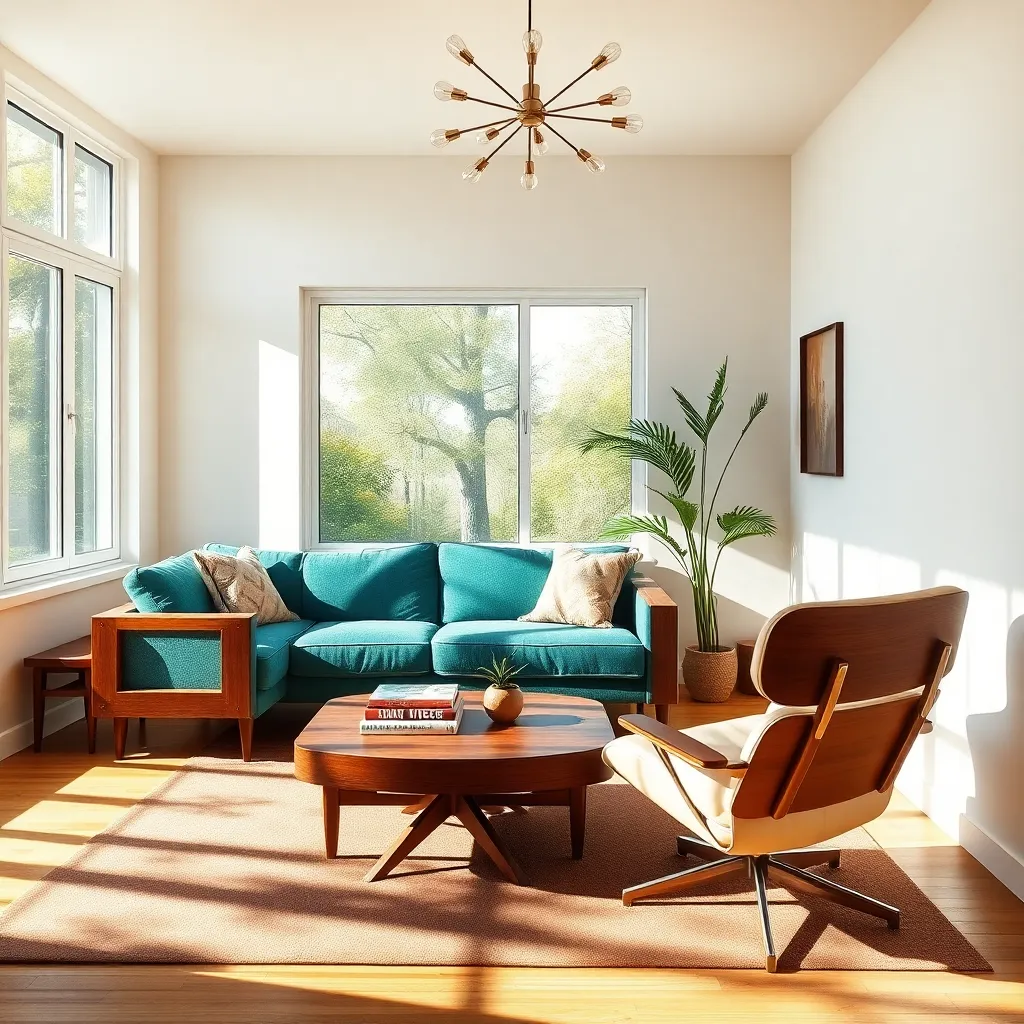
When incorporating iconic furniture pieces into your mid-century modern decor, start by choosing a statement piece like the Eames Lounge Chair. Its sleek lines and leather upholstery can be the focal point of a living room, providing both style and comfort.
Consider pairing such a chair with a simple Noguchi coffee table to maintain a balanced aesthetic. The table’s organic shape and minimalist design seamlessly fit into a mid-century theme, creating an inviting space without overwhelming the room.
For beginners, focus on classic materials such as walnut or teak when selecting furniture. These woods not only reflect the era’s design ethos but also add warmth and richness to your space.
Advanced decorators might explore mixing iconic pieces with contemporary accents to create a personalized look. Use contrasting textiles, like a bold geometric rug, to add depth without detracting from the furniture’s timeless appeal.
Choose Warm Wood Tones
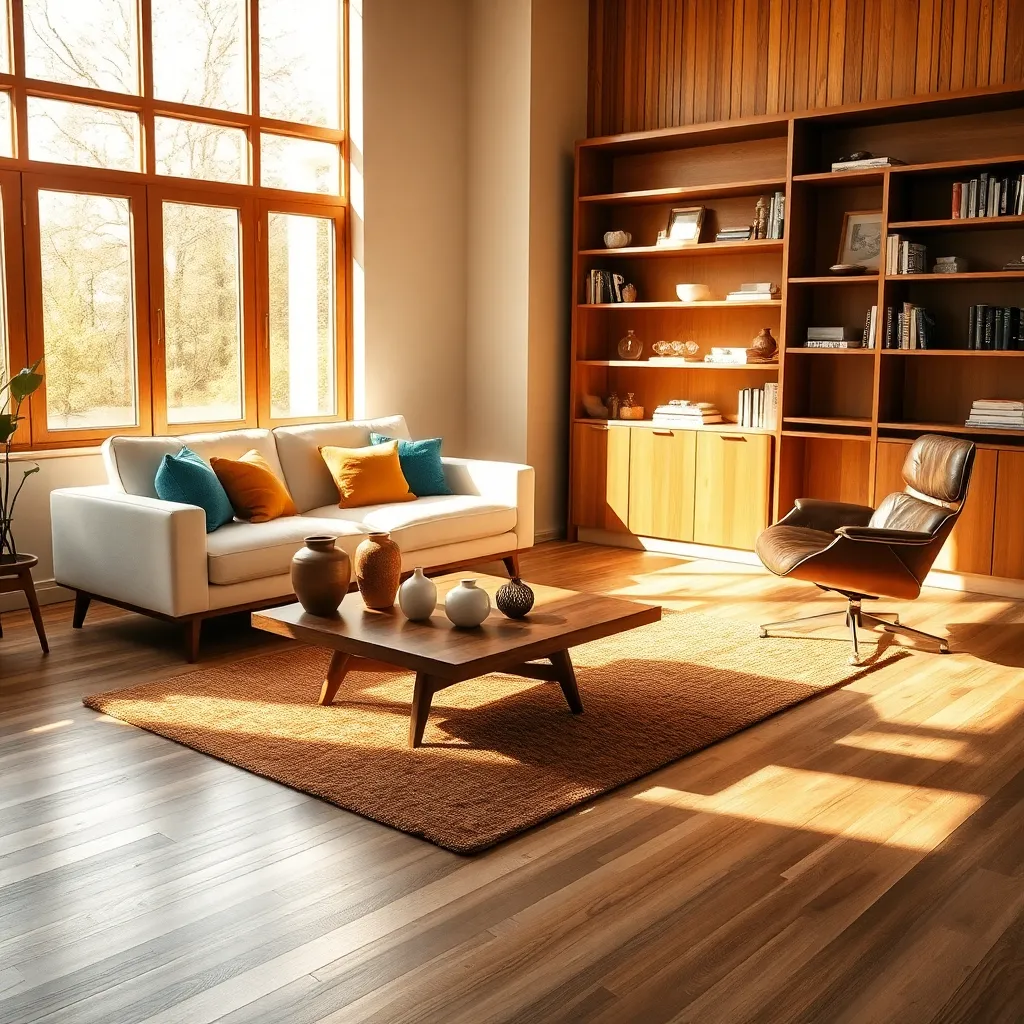
To evoke the inviting charm of mid-century modern design, focus on choosing warm wood tones for your furniture and decor. Opt for pieces crafted from teak, walnut, or oak, as they offer a rich palette that complements the clean lines and functional forms typical of the style.
Begin by selecting a statement piece, such as a dining table or a media console, in a warm wood finish to anchor your space. Pair it with lighter or neutral-colored accents, like white walls or cream textiles, to create a balanced and harmonious look.
For a cohesive design, incorporate smaller wooden elements throughout the room, such as picture frames or shelving. These touches reinforce the warm ambiance and provide continuity without overwhelming the space.
Advanced decorators might consider mixing different wood tones for a more dynamic and layered effect. To maintain a cohesive look, ensure these tones share similar undertones, avoiding clashing hues that might disrupt the flow of your interior.
Add Geometric Patterns
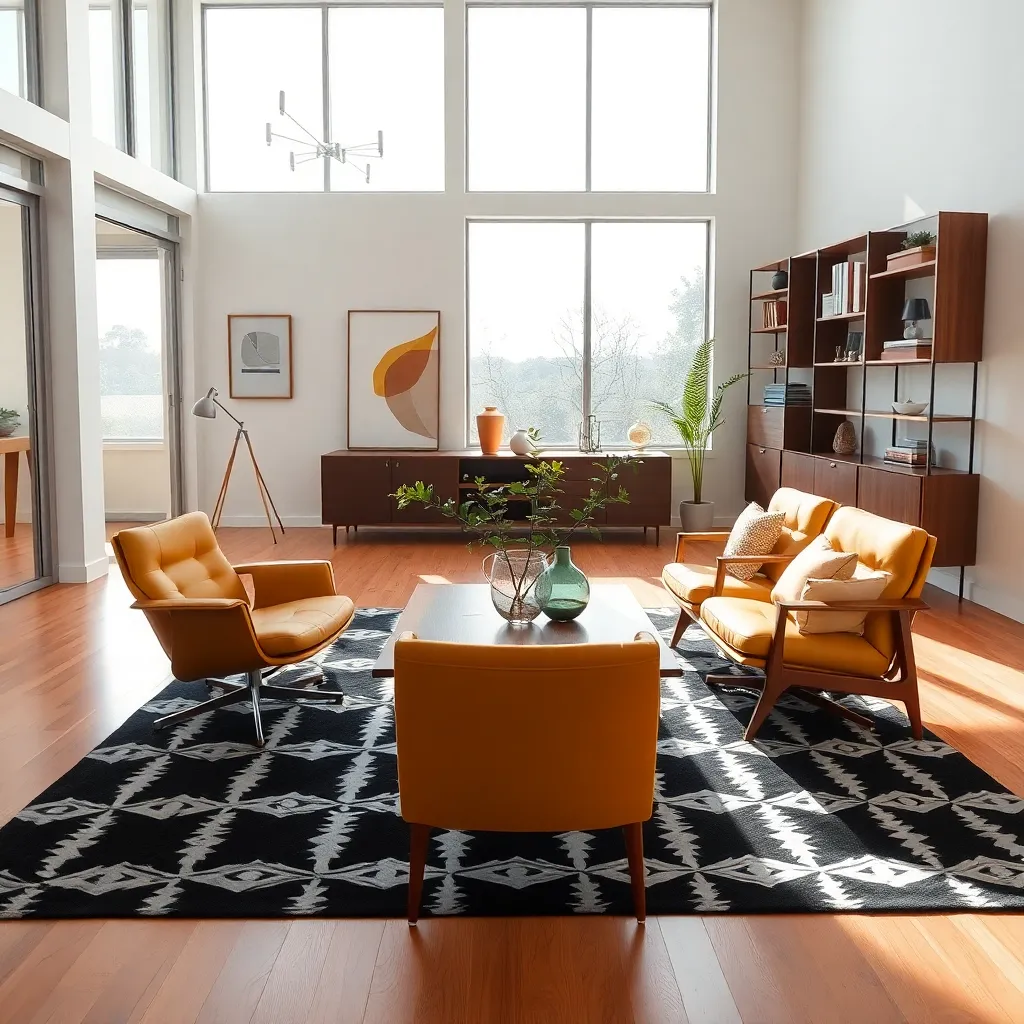
Incorporating geometric patterns into your mid-century modern space can add visual interest and a touch of sophistication. Start by introducing a geometric rug with bold shapes and colors to anchor the room, creating a striking focal point.
For a subtler approach, consider using geometric patterns in your textiles, such as throw pillows or curtains. Opt for a mix of complementary colors like mustard yellow and teal to maintain a cohesive look.
Enhance your walls with geometric wallpaper or a feature wall painted in geometric designs. This can be a great way to add depth and dimension to a room, particularly if you choose a pattern that contrasts with your existing color palette.
Advanced decorators might experiment with layering geometric patterns across different elements in the room, such as furniture upholstery and wall art. Ensure that the patterns vary in scale to avoid overwhelming the space while still creating a dynamic and engaging environment.
Use Earthy Color Palettes
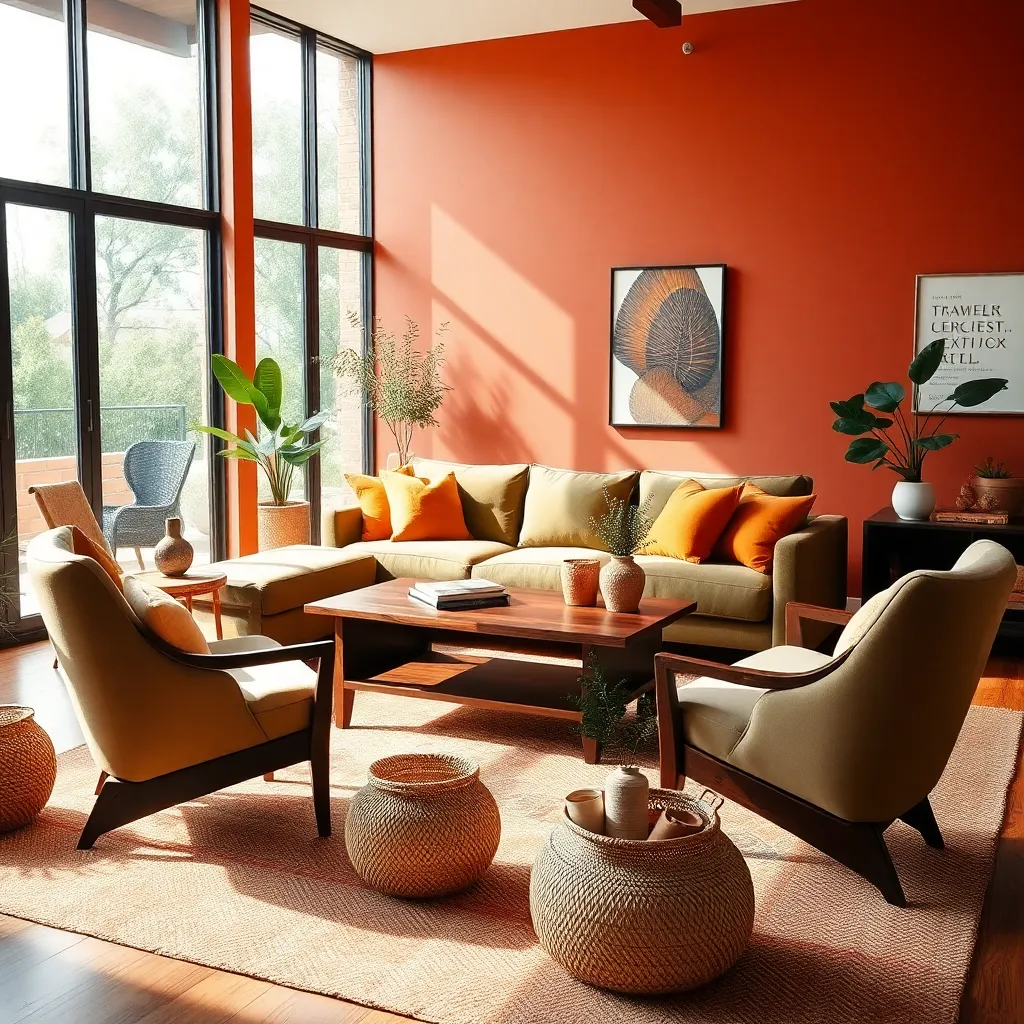
Bringing earthy color palettes into your mid-century modern space can create a warm and inviting atmosphere. Begin by incorporating shades like olive green, terracotta, and mustard yellow, which are staples of the mid-century era and naturally complement wooden furniture.
To implement an earthy palette, consider painting an accent wall in a deep, natural hue to add depth and focus to the room. Pair this with neutral tones on other walls, like beige or taupe, to maintain balance and prevent the space from feeling overwhelming.
Furniture selection is crucial when using earthy colors, so choose pieces in natural materials such as leather, wood, or rattan to enhance the organic vibe. Upholstery in rich browns or warm greys can ground the room, while a mid-century modern coffee table or sideboard in walnut can add a touch of sophistication.
For those looking to advance their design, layer textures by adding a jute rug or linen curtains for an extra layer of warmth and interest. Accessorize with ceramics or clay planters to introduce subtle pops of color and texture, ensuring the room feels cohesive and thoughtfully curated.
Select Sleek Lighting Fixtures
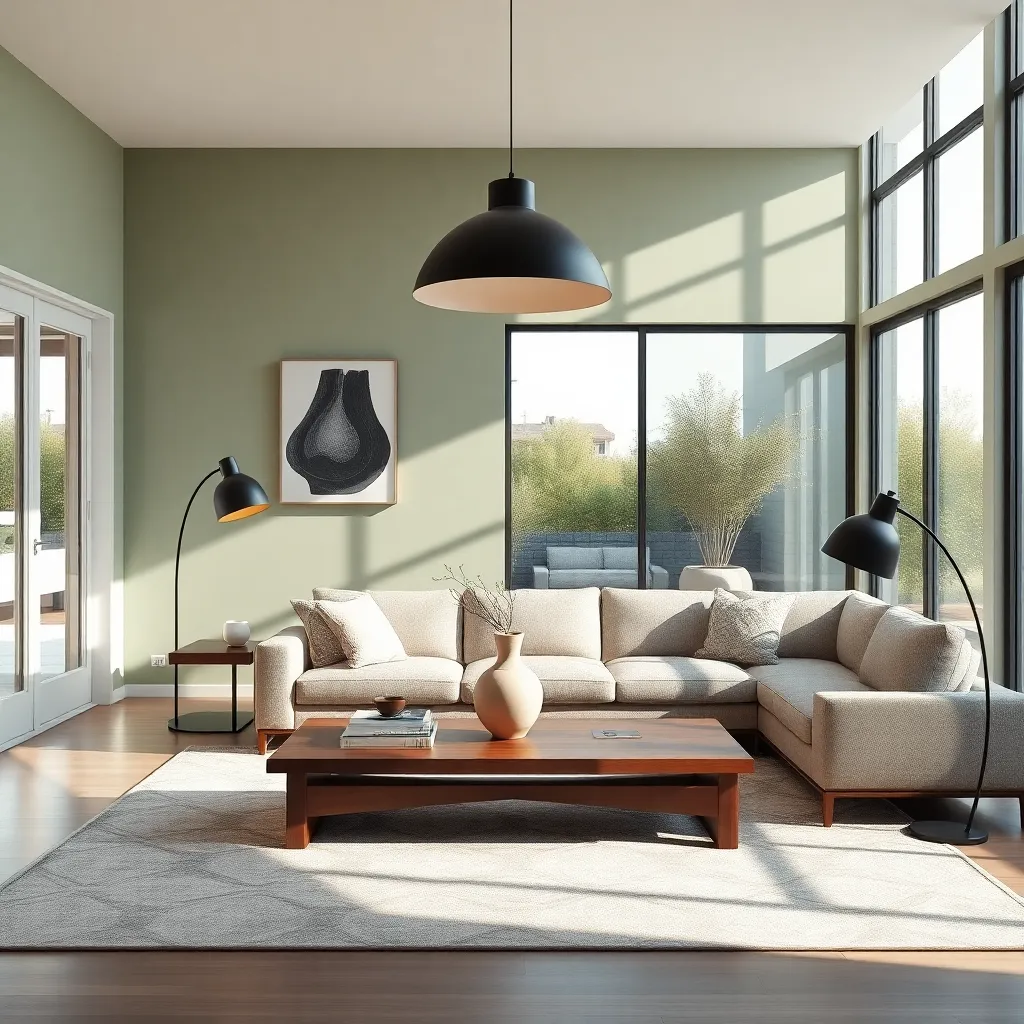
Lighting plays a crucial role in the mid-century modern aesthetic, where sleek lines and minimalist designs are key. Opt for fixtures that feature clean, geometric shapes and materials like metal or glass to enhance the space’s modern appeal.
To create a warm and inviting atmosphere, consider installing pendant lights with a brass or matte black finish. These materials not only provide a nod to mid-century design but also add depth and contrast to neutral or earthy color palettes.
For those looking to make a bolder statement, incorporate a sputnik chandelier in a dining or living area. This iconic lighting fixture, with its starburst design, can serve as a focal point and amplify the overall aesthetic of the room.
Don’t overlook the importance of task lighting, especially in areas like the kitchen or home office. Adjustable floor or table lamps with an industrial edge can provide the necessary illumination while maintaining the sleek and functional design elements characteristic of mid-century modern interiors.
Display Abstract Artwork
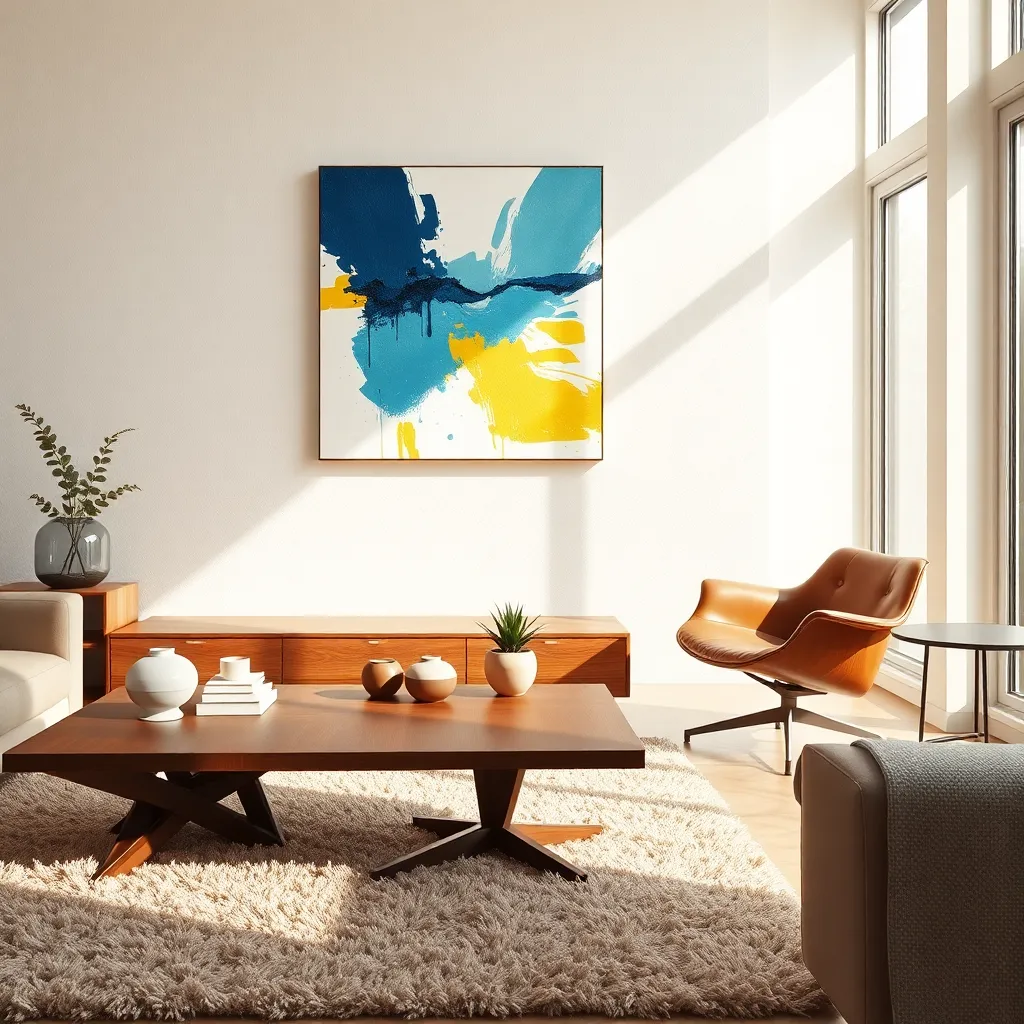
Abstract artwork can be a stunning focal point in a mid-century modern interior. To effectively showcase these pieces, choose a wall with minimal distractions, allowing the art to stand out.
When selecting artwork, consider pieces that incorporate the signature bold colors and geometric shapes of the mid-century modern style. These elements will complement your existing decor and enhance the overall aesthetic.
For a cohesive look, coordinate the colors in the artwork with your furniture and accessories. This doesn’t mean everything should match; instead, opt for complementary hues that create a harmonious balance across the room.
Placement is crucial when displaying abstract art. Hang pieces at eye level to ensure they are appreciated fully, and use a simple frame to maintain the artwork’s prominence without overwhelming the space.
Integrate Organic Textures
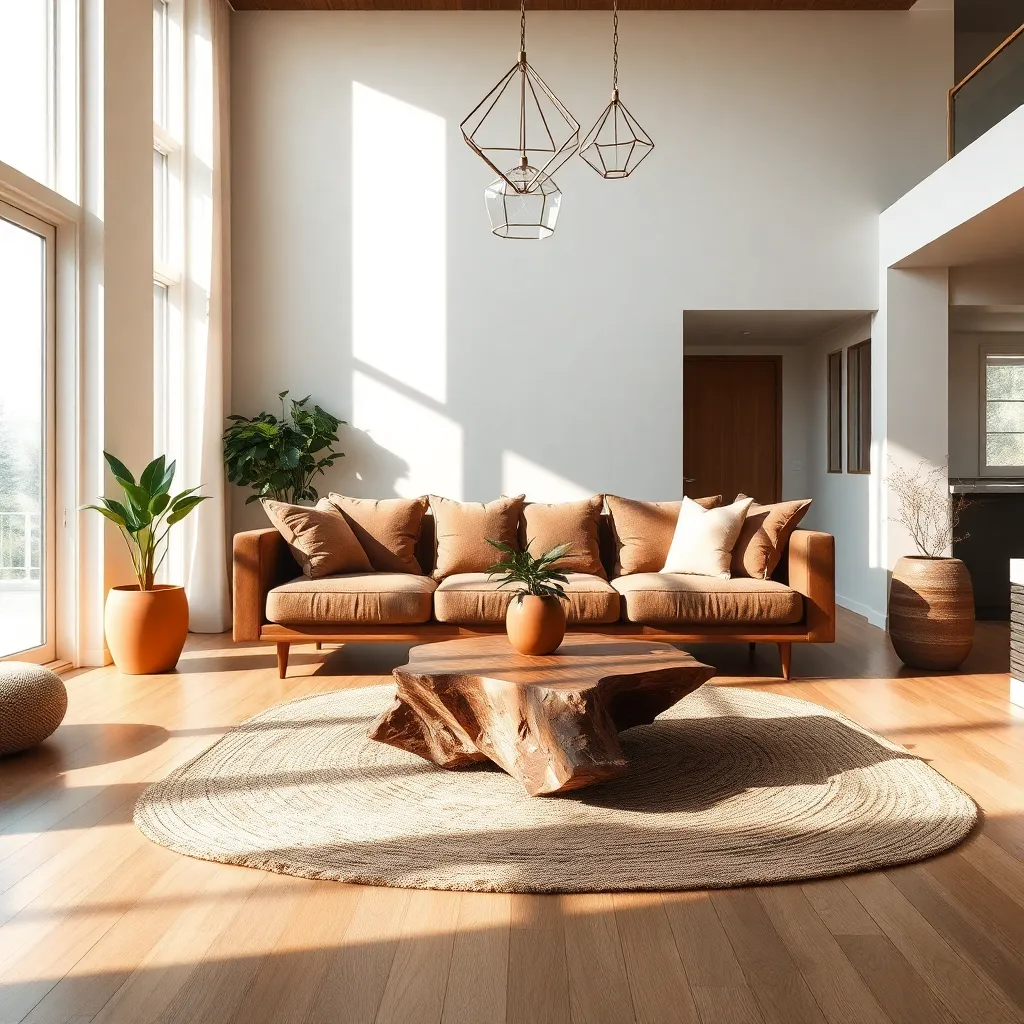
Incorporating organic textures into your mid-century modern space can create a warm, inviting ambiance. Start by introducing natural materials like wood, leather, and woven fibers into your furniture and accessories.
Consider adding a teak or walnut coffee table to anchor your living room and introduce rich, earthy tones. Pair this with a soft, plush wool rug to add dimension and a cozy underfoot feel.
For a more advanced touch, experiment with layering different textures through textiles such as linen curtains or a jute wall hanging. These elements not only enhance the tactile experience but also add depth and interest to your design.
Don’t overlook the power of plants to bring in organic texture and life. Choose a variety of species with different leaf shapes and sizes to create a visually dynamic display that complements the clean lines of mid-century modern design.
Opt for Low-Profile Sofas
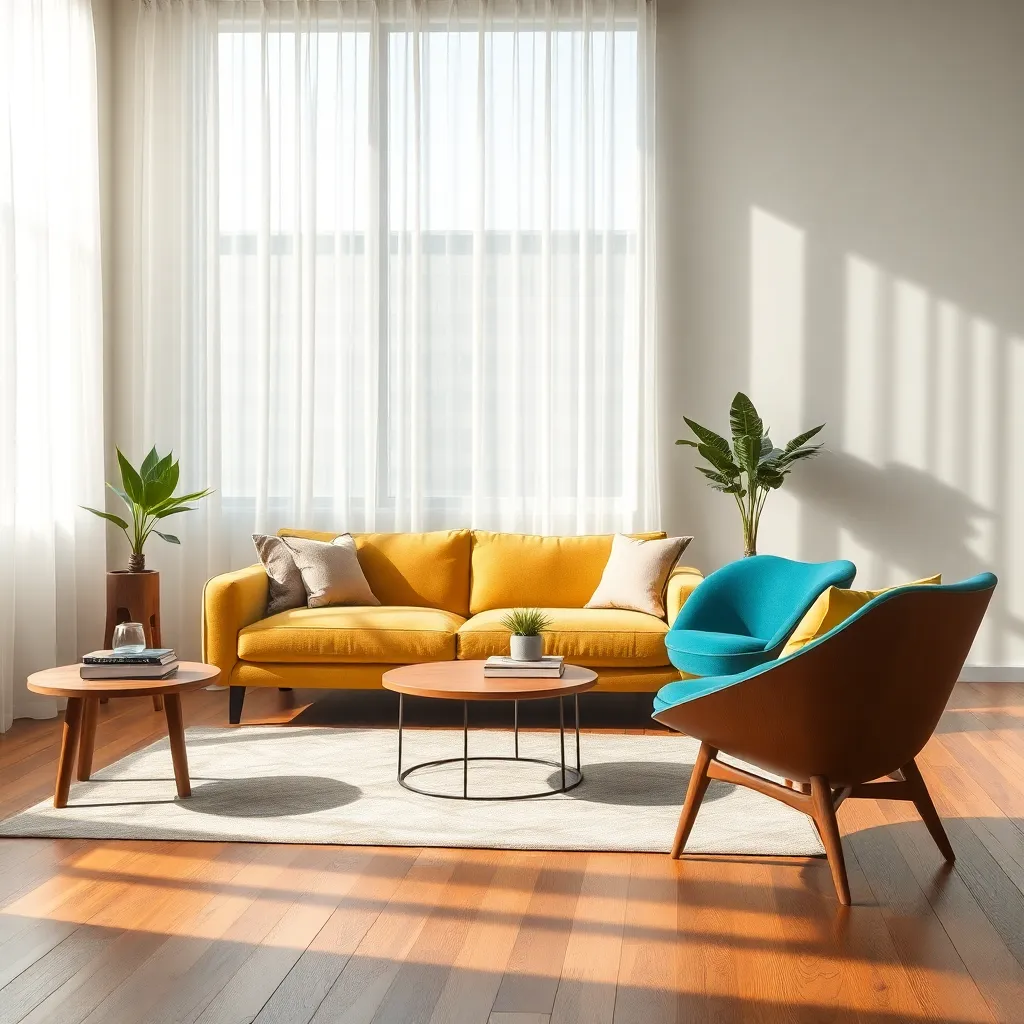
Incorporating low-profile sofas into your mid-century modern design can significantly enhance the open and airy feel of your living space. These sofas typically feature clean lines and minimalistic designs, making them ideal for creating a seamless flow in your room.
When choosing a low-profile sofa, consider options with a low back and sleek, tapered legs to accentuate the mid-century aesthetic. Opt for materials such as leather or linen in neutral colors like gray, beige, or soft earth tones to maintain a sophisticated look.
Placement is key to maximizing the impact of a low-profile sofa. Position it away from walls to create a more inviting and conversational seating arrangement, encouraging interaction and movement within the space.
For those ready to take their design to the next level, experiment with bold accessories like geometric-patterned pillows or a vibrant area rug. These additions can provide contrast and texture, enhancing the visual appeal without overwhelming the understated elegance of the sofa.
Include Statement Rugs
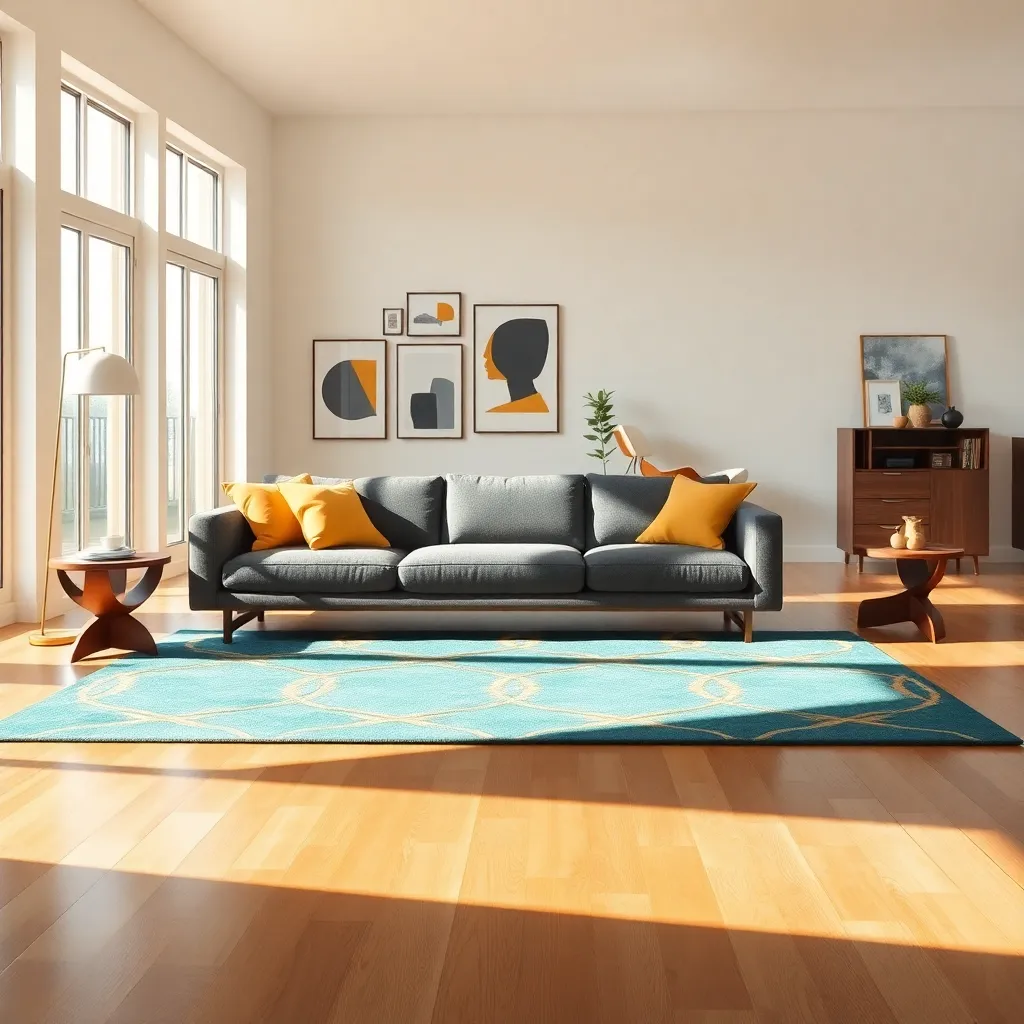
Incorporating statement rugs is a brilliant way to anchor your mid-century modern space while adding a burst of personality. Select rugs with bold geometric patterns or rich, earthy tones to complement the streamlined furniture typical of this style.
To effectively use a statement rug, ensure it is large enough to fit under all major furniture pieces in the room, such as the sofa and coffee table, creating a cohesive look. Opt for natural materials like wool or jute, which not only provide durability but also enhance the textural contrast in your design.
Experiment with color by choosing a rug that either harmonizes with your current palette or introduces a new accent color. This approach allows you to subtly shift the mood of your space without overwhelming the existing decor. For advanced decorators, consider layering rugs to add depth and dimension—this technique works particularly well with neutral-toned rugs as a base.
Placement is key; in living rooms, position your rug so that it extends beyond the edges of your seating area to visually expand the space. In dining rooms, ensure the rug is large enough that chairs remain on the rug even when pulled out. Remember, a well-placed statement rug can define areas within open floor plans, making it a versatile tool in your design arsenal.
Blend Indoor and Outdoor Spaces
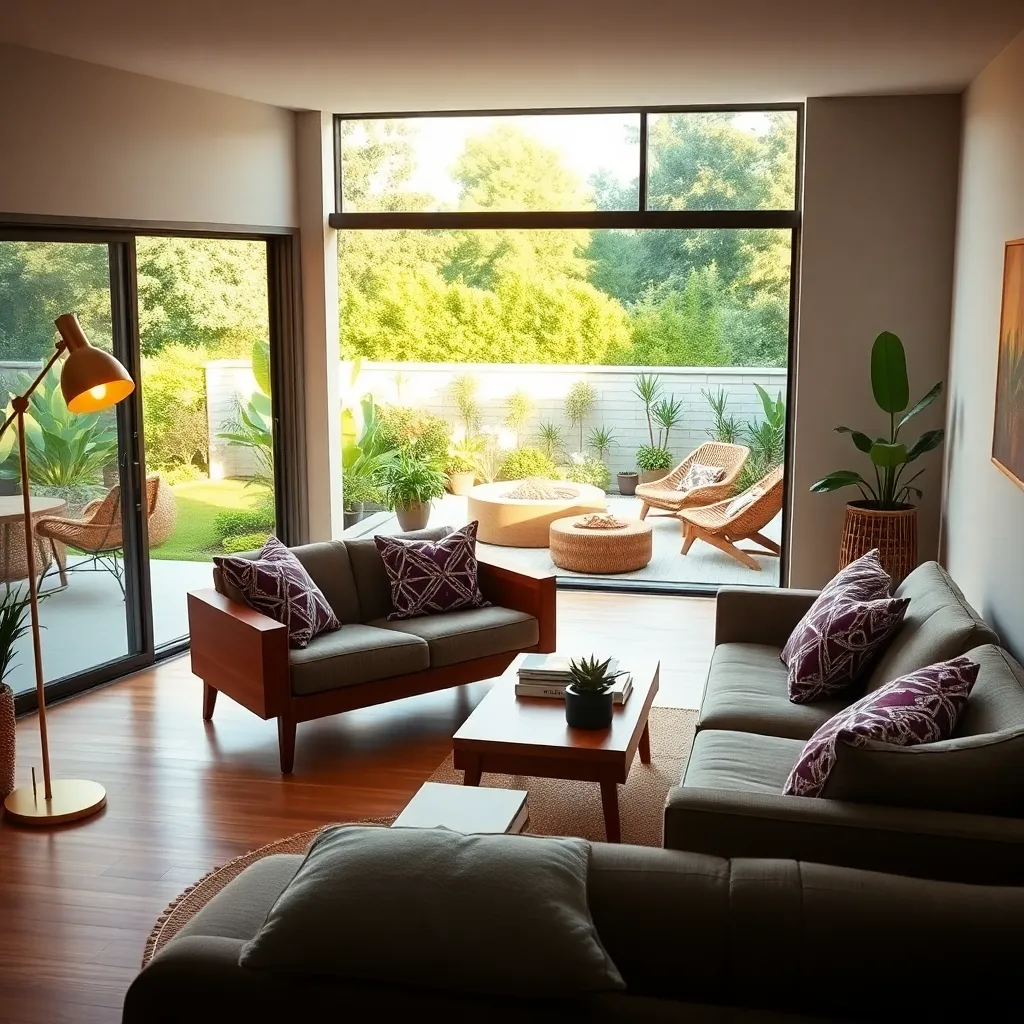
Creating a seamless flow between indoor and outdoor spaces can significantly enhance the mid-century modern aesthetic of your home. Start by using large, sliding glass doors or expansive windows to visually open up your living space and invite natural light inside.
Consider extending your interior color palette to the exterior for a cohesive look. Use similar shades and materials, such as wood or concrete, for both indoor and outdoor furniture to create a unified design language.
Incorporate plants strategically to blur the lines between the inside and outside. Place potted plants both inside near your windows and outside on your patio or deck to create a lush, inviting atmosphere.
For a more advanced touch, invest in versatile furniture pieces that can easily transition between indoor and outdoor use. Look for durable materials like teak or weather-resistant fabrics in mid-century designs to maintain style consistency while ensuring longevity.
Highlight Minimalist Decor
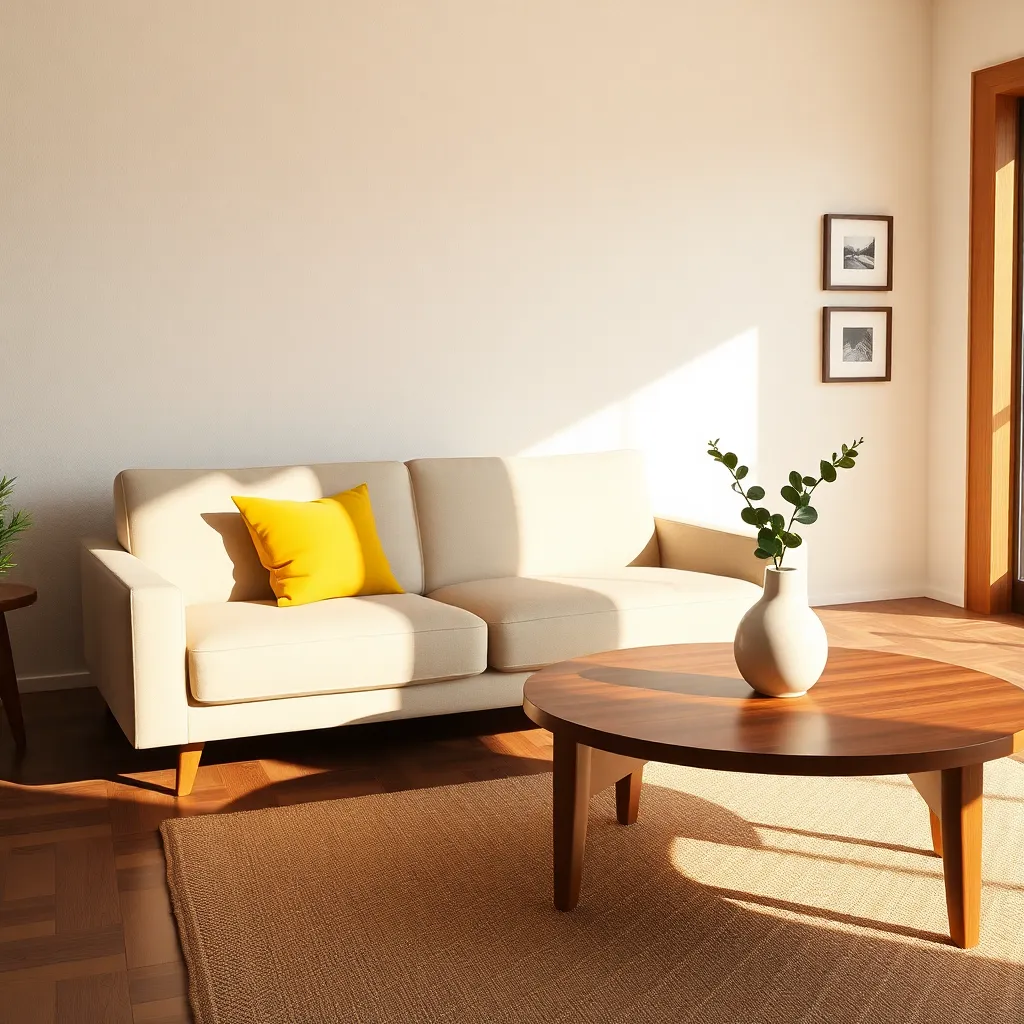
Incorporating minimalist decor into your mid-century modern space can create an atmosphere of tranquility and openness. Start by selecting furniture with clean lines and a simple silhouette, such as a streamlined sofa or a sleek coffee table.
Declutter your space by choosing pieces that offer both style and functionality, like a storage bench or a console with hidden compartments. Keep surfaces clear and opt for a neutral color palette—think whites, greys, and soft beiges—to enhance the minimalist aesthetic.
To add depth without overwhelming the room, introduce texture through materials like wool, leather, or wood. A wool throw draped over the couch or a wooden side table can add warmth while still adhering to minimalist principles.
Consider incorporating a few strategically placed accessories to express personal style, such as a single large art piece or a striking geometric sculpture. These elements should serve as focal points, drawing the eye without cluttering the space.
Balance Old and New Elements
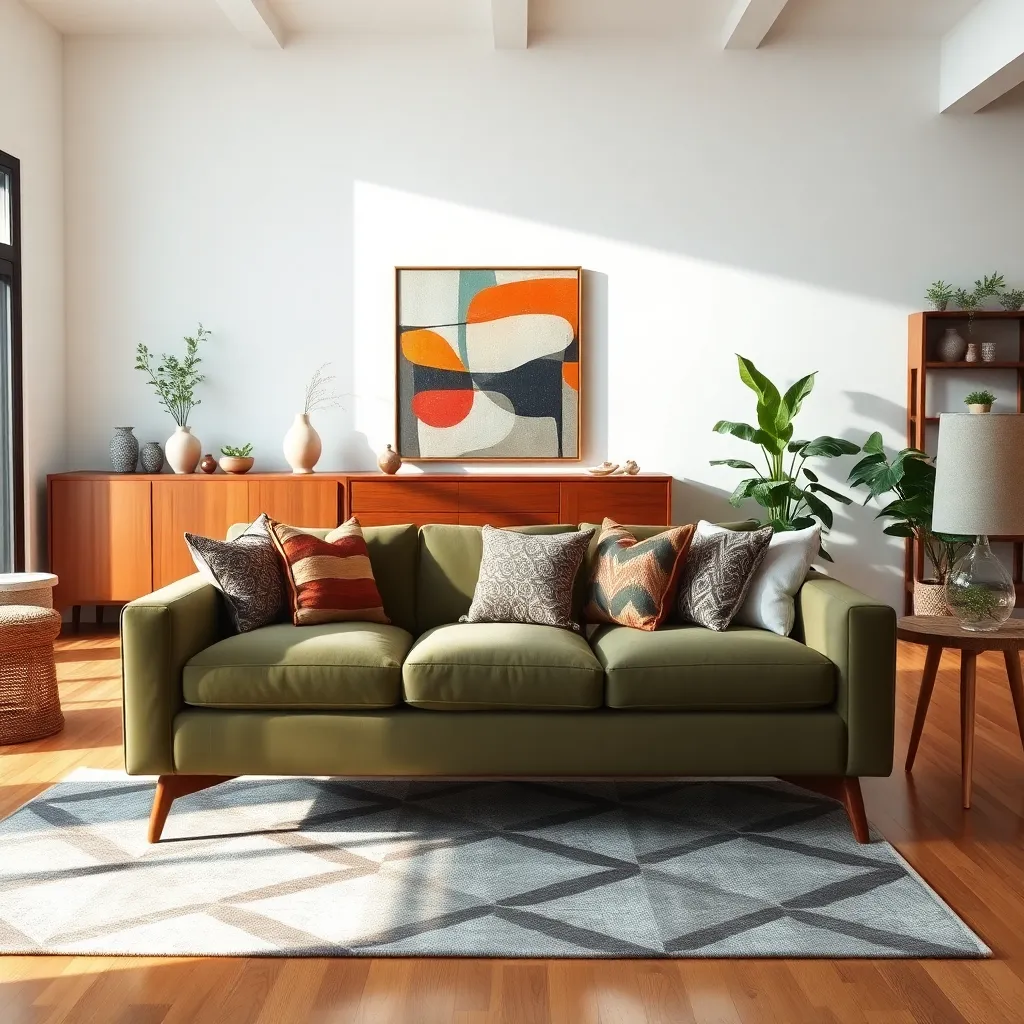
To successfully balance old and new elements in your mid-century modern decor, start by selecting a focal piece from each era. For instance, pair a vintage walnut credenza with a sleek, contemporary sofa, ensuring both pieces share a complementary color scheme or material to create harmony.
Consider the interplay of textures to bridge the gap between different styles. A mid-century modern wool rug can soften the look of an industrial-style metal coffee table, creating a cohesive and inviting space.
Using a neutral color palette as the foundation allows both old and new elements to shine. Incorporate soft whites or muted greys on walls and larger furniture pieces, and then introduce pops of color through accessories like cushions or artwork to maintain interest.
Advanced decorators can experiment with layering different lighting styles to enhance the mix of old and new. Combine a vintage arc floor lamp with modern recessed lighting to add depth and dimension to your room, ensuring each area is well-lit and stylish.
Conclusion: Growing Success with These Plants
As we journey through the 12 inspirational mid-century modern interior tips, we’ve discovered valuable insights that transcend design and echo into our relationships. Firstly, embracing minimalism encourages clarity and focus, while integrating natural elements nurtures growth and harmony. Balancing open spaces and personal nooks fosters both connection and individuality. The strategic use of color enhances moods, while mixing textures mirrors the beauty of diversity in relationships. Incorporating vintage pieces reminds us of the importance of history and legacy. Functional furniture emphasizes the need for support, and geometric patterns inspire creativity and innovation. Lastly, celebrating imperfections highlights authenticity, and sustainable choices underscore commitment to longevity.
As an actionable next step, select one element that resonates most with your relationship and implement it today, whether it’s creating a cozy nook for meaningful conversations or adding a splash of color to invigorate your space.
We encourage you to bookmark this article for future reference, ensuring these timeless tips remain at your fingertips. Remember, nurturing your relationship is a continuous journey, and these insights can guide you towards a fulfilling and successful partnership. Taking these steps today paves the way for a thriving relationship tomorrow. Save this guide and make your relationship a masterpiece in progress.
